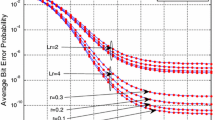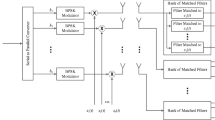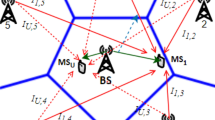Abstract
DS/CDMA noncoherentM-ary orthogonal signaling is presented in a hexagonal cell with three and six corner-based antennas. Multipath Rayleigh channel with lognormal shadowing and perfect power control are assumed. The asynchronous case (uplink) is studied. Bit error rate analysis is carried out to investigate the benefits of combining theM-ary orthogonal signaling and macrodiversity techniques either with uncorrelated or correlated base stations. Comparative analysis between the one central antenna arrangement and the proposed one is presented. The results show that the combination ofM-ary signaling with multiple corner-based antennas improves system performance especially in terms of accommodating more users and supporting new services. The results also show that shadowing does not degrade system performance significantly.
Similar content being viewed by others

References
A. Viterbi, Implications of mobile cellular CDMA,IEEE Communications Magazine, Vol. 30, No. 12, pp. 38–41, 1992.
S. Ariyavisitakul, SIR-based power control in a CDMA system,Proc. Globecom'92, pp. 868–873, 1992.
A. A. Dayya and N. C. Beaulieu, Micro- and macrodiversity NCFSK (DPSK) on shadowed Nakagami-fading channels,IEEE Transactions on Communications, Vol. 42, No. 9, pp. 2693–2702, 1994.
A. M. D. Turkmani, Performance evaluation of a composite microscopic plus macroscopic diversity system,IEE ProceedingsI, Vol. 138, No. 1, pp. 15–20, 1991.
K. S. Gilhousen, I. M. Jacobs, R. Padovani, A. J. Viterbi, L. A. Weaver, Jr., and C. E. Wheatley III, On the capacity of a cellular CDMA,IEEE Transactions on Vehicular Technology, Vol. 40, No. 2, pp. 303–312, 1991.
A. Kajiwara, Effect of cell size, directional antennas, diversity and shadowing on indoor radio CDMA capacity,Proc. IEEE 5th PIMRC'94, pp. 60–64, 1994.
P. K. Enge and D. L. Sarwate, Spread-spectrum multiple-access performance of orthogonal codes: linear receivers,IEEE Transactions on Communications, Vol. 35, No. 12, pp. 1309–1319, 1987.
M. Chase and K. Pahlavan, Performance of DS-CDMA over measured indoor radio channels using random orthogonal codes,IEEE Transactions on Vehicle Technology, Vol. 42, No. 4, pp. 617–624, 1993.
L. M. A. Jalloul and J. M. Holtzman, Performance analysis of DS/CDMA with noncoherentM-ary orthogonal modulation in multipath fading channels,IEEE Journal on Selected Areas in Communications, Vol. 12, No. 5, pp. 862–870, 1994.
P. I. Dallas, A. C. Iossifides, and F-N. Pavlidou, A modified RAKE receiver for a DS/CDMA cellular mobile system,Proc. IEEE 5th PIMRC'94, pp. 1419–1423, Sept. 1994.
P. I. Dallas and F-N. Pavlidou, DS/CDMAM-ary orthogonal signalling in a shadowed Rayleigh channel for mobile communication.Wireless Networks, to appear.
K. Pahlavan and M. Chase, Spread-spectrum multiple-access performance of orthogonal codes for indoor radio communications,IEEE Transactions on Communications, Vol. 38, No. 5, pp. 574–577, 1990.
H. S. Misser and R. Prasad, Spectrum efficiency of a mobile cellular radio system using direct sequence spread spectrum,Preconf. Proc., Vol. III, Computer and Communications, IEEE Tencon'91, pp. 91–94, 1991.
Q. Bi, Performance analysis of CDMA cellular system,Proc. IEEE 42nd Veh. Technol. Conf., pp. 43–46, 1992.
J. G. Proakis,Digital Communications, McGraw Hill, New York, 1989.
I. Gradshteyn and I. M. Ryzhik,Tables of Integrals, Series and Products, Academic Press, New York, 1980.
A. A. Dayya and N. C. Beaulieu, Outage probabilities in the presence of correlated lognormal interferers,IEEE Transactions on Vehicle Technology, Vol. 43, No. 1, pp. 164–173, 1994.
A. Papoulis,Probability, Random Variables and Stochastic Processes, 3rd ed., McGraw Hill, New York, 1991.
M. Kavehrad and P. J. McLane, Performance of low-complexity channel coding and diversity for spread spectrum in indoor, wireless communication,AT&T Technical Journal, Vol. 64, No. 8, pp. 1927–1964, 1985.
E. Lloyd,Handbook of Applicable Mathematics: Vol. II. Probability, Wiley, New York, 1980.
S. M. Ermakov,Die Monte-Carlo-Methode und verwandte Fragen, VEB Deutscher Verlag der Wissenschaften, Berlin, 1975.
J. H. Wilkinson,The Algebraic Eigenvalue Problem, Monographs on Numerical Analysis, Oxford University Press, London, 1985.
Author information
Authors and Affiliations
Rights and permissions
About this article
Cite this article
Dallas, P.I., Pavlidou, FN. Macrodiversity analysis of anM-ary noncoherent orthogonal DS/CDMA system on shadowed Rayleigh channels. Int J Wireless Inf Networks 3, 163–172 (1996). https://doi.org/10.1007/BF02365826
Issue Date:
DOI: https://doi.org/10.1007/BF02365826



